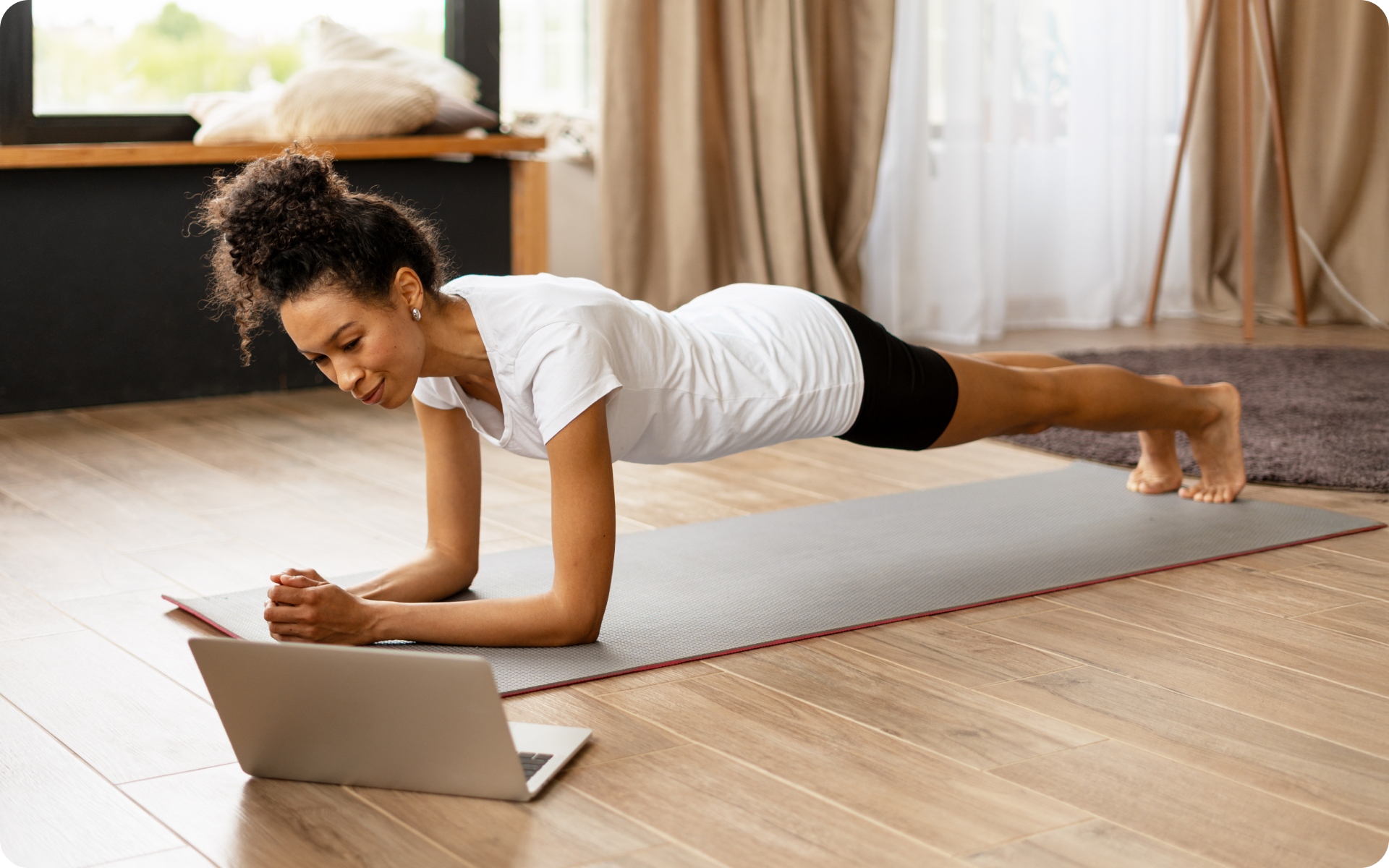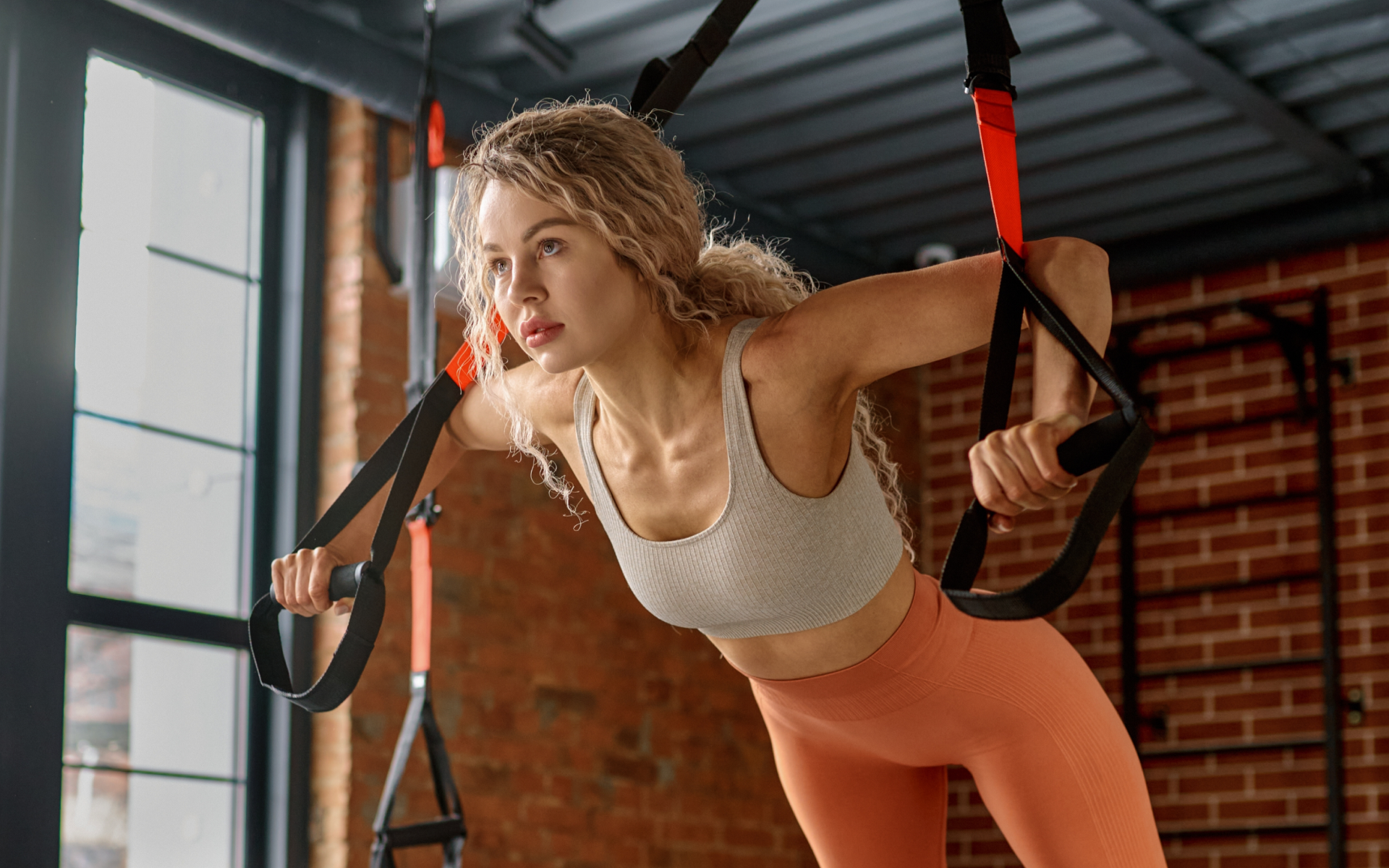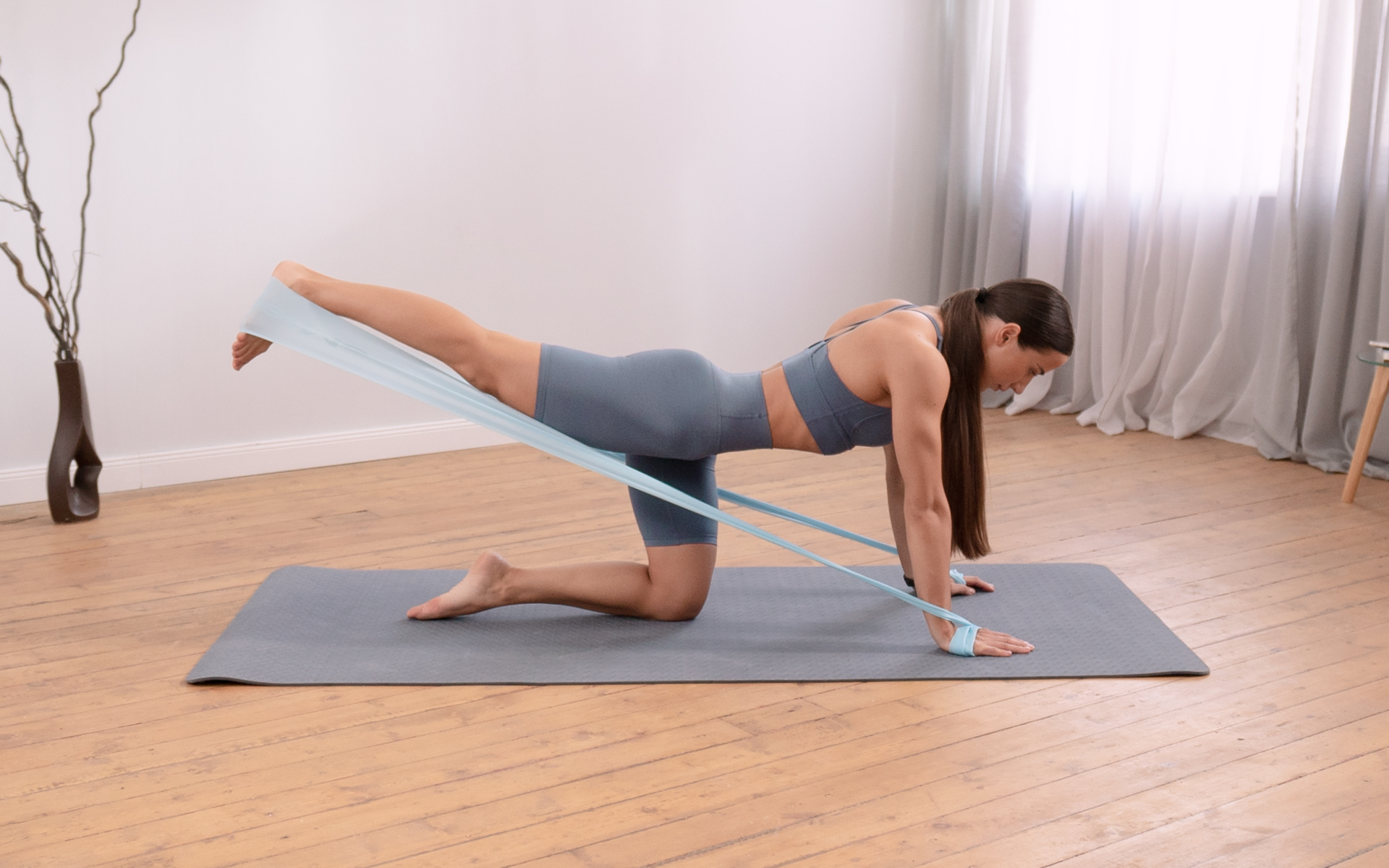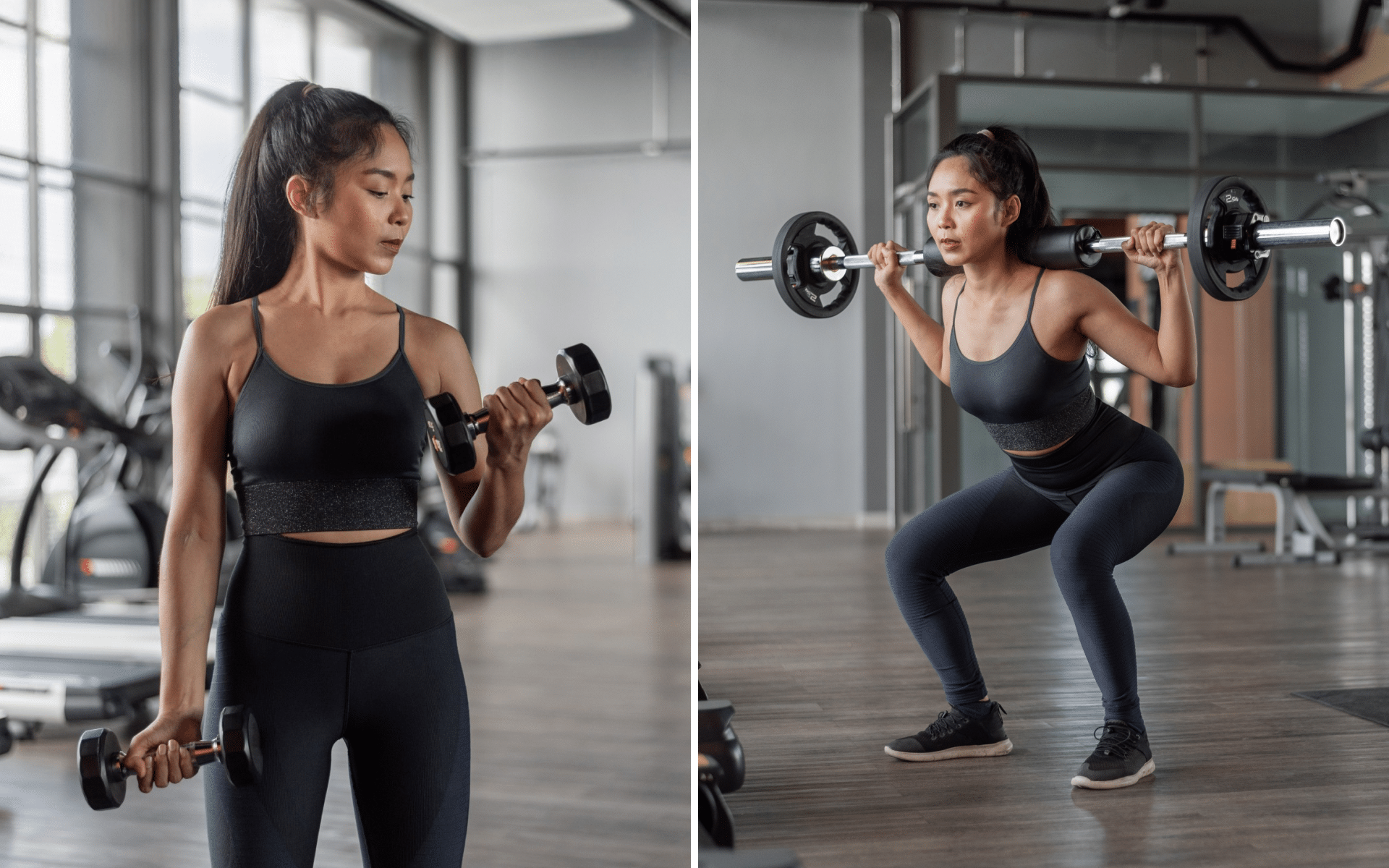You’re here because you’ve been told a dozen times to “brace your core”, but you somehow never seem to do it right. Should you suck in your stomach? Should you hold your breath? Is it even possible to brace your core properly when you can’t see it?
Here’s the answer: The key to bracing your core correctly is an isometric contraction. This means you contract your muscles without the muscles actually lengthening. Conversely, an isotonic contraction is where there is an eccentric (muscle lengthening) and concentric phase (muscle shortening). For an isotonic contraction, think of a bicep curl. As you bring the weight up, the bicep muscle will shorten (concentric) and as you lower the weight back down (eccentric), the bicep muscle will lengthen.
The best way to do an isometric contraction of your stomach is to breathe in through your chest and breathe out through your stomach. As you breathe out through your stomach, you’ll tighten your abdominal muscles and suck your belly button toward your back. You should feel your abdominal muscles contract. Hold this contraction for 10-20 seconds.
Read on for insights into how to properly brace your core and avoid common mistakes.
What Does Bracing Your Core Mean?
Bracing is the act of consciously contracting your abdominal muscles to create stability around your spine. When done correctly, bracing can provide support for your spine and help prevent injury (1). It’s something that you can practice and improve with repetition. The ultimate goal of this practice is to sub-consciously create intra-abdominal pressure with these movements.
Follow these steps to brace your core:
- Start by standing tall with your feet hip-width apart.
- Take a deep breath in through your chest
- As you breathe out through your stomach, engage your abdominal muscles by tightening them as if about to be punched in the stomach.
- Hold this contraction for 5-10 seconds.
- Relax and repeat.
Does Bracing Work Your Core?
Yes, it does. Bracing can strengthen your core muscles, including your (2):
- Rectus abdominis: This is the “six-pack” muscle that runs down the front of your stomach.
- External obliques: These are the muscles on the sides of your stomach.
- Internal obliques: These are the muscles under your rectus abdominis.
- Transverse abdominis: This is the deepest layer of abdominal muscle and wraps around your sides and back.
What Are the Benefits of Bracing Your Core?
There are many benefits to bracing your core, including:
1. Reduced Risk of Injury
Your core muscles act as a natural “corset” for your spine (3). When they’re strong and can contract quickly, they can help prevent injuries to your spine and other joints.
2. Improved Posture
Bracing your core helps retrain your muscles to maintain good posture (4). This can help prevent neck, shoulder, and lower-back pain.
3. Better Balance and Stability
A strong core allows you to maintain good balance and stability, whether walking, running, or lifting weights (4).
4. Improved Athletic Performance
Bracing your core can help you run faster, jump higher, and lift heavier weights (4). A strong core provides a stable foundation for your body to work from.
5. Greater Mental Focus
When your core is strong and stable, it takes less effort for your body to maintain balance. This frees up your brain power to focus on other things.
6. Increased Energy Levels
A strong and stable core can help you move more efficiently, which gives you more energy for other activities (4).
7. Better Digestion
The transverse abdominis muscle wraps around your stomach and helps compress the contents of your gut. This can help improve digestion and prevent bloating (5).
8. Reduced Back Pain
Strengthening your core muscles can help reduce or eliminate lower-back pain. This is because a strong core helps support your spine and take pressure off your back muscles (6).
9. Improved Breathing
The diaphragm is a muscle that sits under your lungs and helps you breathe. A strong core can help improve the function of your diaphragm and increase your lung capacity. This is the muscle that works when you’re attempting to brace your core. When you inhale, your diaphragm expands and when you exhale, it contracts. As the diaphragm contracts, you can focus on tightening your stomach, which helps make the mind-muscle connection with bracing the core.
BetterMe is your fast-track ticket to a long-lasting weight loss! Tailor your fitness journey and maximize your results with just a couple of swipes!
10. Greater Strength and Power Transfer from the Lower Body to the Upper Body
A strong core is essential for transferring power from your lower body to your upper body (8). This is because your core muscles act as a link between your lower and upper body.
11. Increased Flexibility
A strong and stable core can help you move more efficiently, which leads to increased flexibility.
12. Better Balance Between the Left and Right Sides of the Body
A strong core can help improve your posture and alignment (7), leading to better balance between your body’s left and right sides.
13. More Confidence
Walking, standing, and sitting upright with good posture can make you look and feel more confident.
14. Improved Joint Health
A strong and stable core can help reduce the stress on your joints (7), which will improve your joint health.
To keep your core strong and stable, it must work together quickly, using different body parts. Your core muscles can be divided into two groups: those that keep things stable and those that help you move. Your brain and nerves play a significant role in ensuring these muscles work together smoothly to keep you balanced and steady, particularly when you’re moving around.
All the perks discussed so far demonstrate that bracing your core can benefit anyone who does it with consistency and correct form. Instead of worrying about how long it could take to get in shape, you should focus on the larger goals: better mental health, improved energy levels, and the confidence to face physical challenges head-on!
Amazing Abdominal Bracing Exercises
We’ve compiled a list of other ways to help you brace your core correctly. These exercises can strengthen your core and make you better able to brace when lifting weights:
1. Pelvic Tilt
This is a great way to get into the habit of bracing your core without even thinking about it:
- The pelvic tilt involves simply tucking your tailbone under so your lower back is flat against the floor or ground.
- To do this, lie on your back with your knees bent and your feet flat on the floor.
- Flatten your lower back against the floor by tilting the lower portion of your pelvis upward and tucking your tailbone.
- As you breathe out, you should feel your abdominals engage. This can also help pin your lower back to the floor even more.
- Hold this position for 5-10 seconds and repeat 10 times.
2. Kneeling Anti-Extension
This is another great core exercise that will help you develop the habit of bracing your core. To do this:
- Kneel on all fours with your hands under your shoulders and your knees under your hips.
- Tuck your chin and look down at the floor.
- Try to extend your back from here by arching it away from the floor. You should feel your abdominals engage to resist this movement.
- Hold this position for 5-10 seconds and repeat 10 times.
3. Pall of Press
This is a great exercise for developing core stability and strength:
- To do this exercise, stand with your feet shoulder-width apart and hold a band or towel in front of your chest with both hands.
- Brace your core and press the band or towel straight out in front of you.
- Hold this position for 5-10 seconds and then return to the starting position.
- Repeat 10 times.
4. Farmer’s Walk
The farmer’s walk is a great exercise for developing core stability and strength:
- To perform this exercise, stand with your feet shoulder-width apart and hold a dumbbell in each hand.
- Keep your head and chest up, making sure not to slouch your shoulders forward.
- Brace your core and walk forward. Hold this position for 5-10 seconds before returning to the starting position.
- Repeat 10 times.
5. Plank
One of the most asked questions by fitness enthusiasts is whether planks are good for abs. It should be noted that the plank is an excellent exercise for developing core stability and strength:
- To do this exercise, lie on your stomach with your elbows and forearms on the floor and your hands clasped.
- Breathe in through your chest and out through your stomach to brace your core
- Raise yourself so your body is straight from your head to your feet.
- Every breath in will tighten your core even more.
- Hold this position for 15-30 seconds and then return to the starting position.
- Repeat 4 times.
Read more: The Lying Abdominal Stretch: 15 Abs, Core, and Supporting Muscle Stretches
Common Bracing Mistakes to Avoid
When bracing your core, there are some common mistakes you should avoid:
1. Initiating the Brace from the Neck
Initiating the movement from your lower back and not your neck is important. This will ensure that you’re using your abdominal muscles, not your neck muscles.
2. Not Tucking Your Chin
It’s important to tuck your chin to look down at the floor. This will help ensure you’re using your abdominal muscles, not your neck muscles.
3. Not Breathing
It’s important to breathe in through your chest and out through your stomach. These exhales will allow your core to tighten even further, helping to ensure that you’re using your abdominal muscles.
4. Flaring Your Ribs
It’s important to keep your ribs down so that you use your abdominal muscles, not your neck or back muscles.
5. Abdominal hollowing
It’s important to avoid abdominal hollowing. This is when you suck in your stomach excessively so your back is arched. This places unnecessary stress on your spine and can lead to injury.
If you’ve mustered up the courage to crush your weight loss goal, let Betterme take the sting out of this demanding process. Our app will help you restructure your habits, remold your life and crank up your fitness results! To use your core muscles correctly, gently pull your belly button toward your back while exhaling through your stomach. It’s like getting ready for a little punch in the stomach. You should feel some tension in your middle, but not so much that it’s difficult to breathe. This helps keep your back and hips steady when you move. When you’re lifting in the gym or just working out in general, your core will be used throughout any movement. You can specifically target your core using exercises such as planks, bicycle crunch, v-sit pose, and bridge pose. You should talk to a registered fitness expert to seek guidance on properly performing these exercises and to help program a workout plan for you. To get a strong core, you should aim to do core exercises 2 to 4 times a week for 4 to 8 weeks. Popular choices for core exercises include different types of planks, crunches, and trunk twists. Remember that weightlifting will work your core throughout every movement, so even if you’re not specifically targeting your core with an exercise, it will still work to keep your body stable. There isn’t a single “best” exercise for the core. Some exercises that have proven useful include front planks, flutter kicks, Russian twists, dead bugs, and vertical leg crunches. You can choose the exercise according to your flexibility and fitness level. The best exercise is the one that you can do consistently and with proper form. 
FAQs
How do you engage your core correctly?
What is the fastest way to strengthen your core?
How many days does it take to strengthen your core?
What is the very best core exercise?
The Bottom Line
It’s important to learn how to brace your core the correct way. This will help protect your back and strengthen your tummy muscles, making you feel more strengthened and more stable overall. If you avoid common mistakes and practice the techniques you’ve learned, you’ll get better at core bracing over time.
A strong core is a base for moving safely and well, whether working out, doing yoga, or just performing everyday activities. If you practice and pay attention to your core muscles, bracing them will become easy and natural. This could help you stand taller, reduce your likelihood of injury, and potentially improve at sports. Take the time to learn and use these tips, and you’ll get the most out of your core strength.
DISCLAIMER:
This article is intended for general informational purposes only and does not serve to address individual circumstances. It is not a substitute for professional advice or help and should not be relied on for making any kind of decision-making. Any action taken as a direct or indirect result of the information in this article is entirely at your own risk and is your sole responsibility.
BetterMe, its content staff, and its medical advisors accept no responsibility for inaccuracies, errors, misstatements, inconsistencies, or omissions and specifically disclaim any liability, loss or risk, personal, professional or otherwise, which may be incurred as a consequence, directly or indirectly, of the use and/or application of any content.
You should always seek the advice of your physician or other qualified health provider with any questions you may have regarding a medical condition or your specific situation. Never disregard professional medical advice or delay seeking it because of BetterMe content. If you suspect or think you may have a medical emergency, call your doctor.
SOURCES
- Spine Bracing: When to Utilize—A Narrative Review (2023, researchgate.net)
- Trunk Muscle Activities During Abdominal Bracing: Comparison Among Muscles and Exercises (2013, ncbi.nlm.nih.gov)
- Core Stability Training for Injury Prevention (2013, ncbi.nlm.nih.gov)
- Effect of abdominal bracing training on strength and power of trunk and lower limb muscles (2016, researchgate.net)
- What to know about the stomach vacuum exercise (2023, medicalnewstoday.com)
- Core strength training for patients with chronic low back pain (2023, ncbi.nlm.nih.gov)
- The real-world benefits of strengthening your core (2012,harvard.edu)
- Core training and performance: a systematic review with meta-analysis (2023, ncbi.nlm.nih.gov)









